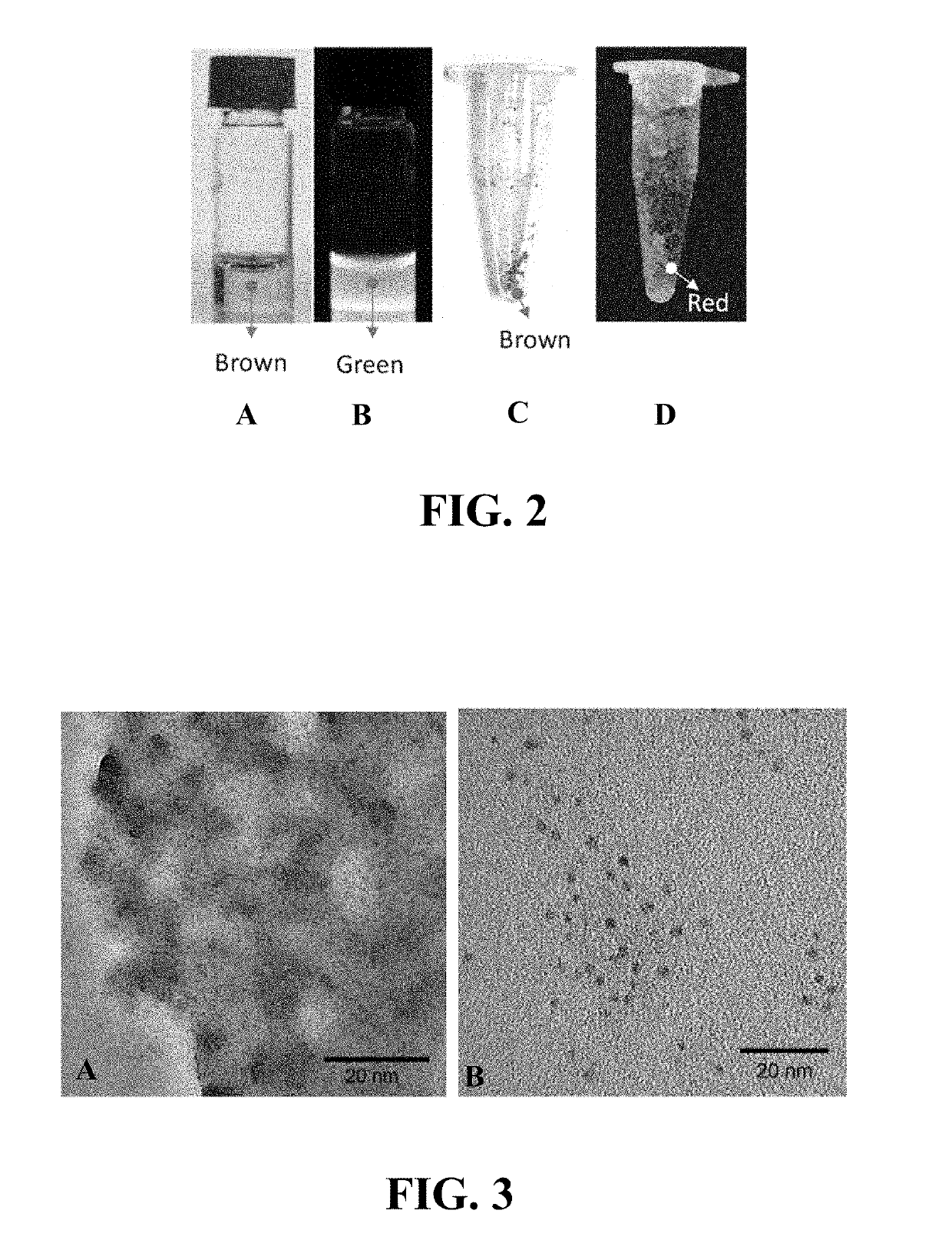Fluorescent nanocomposite
- Summary
- Abstract
- Description
- Claims
- Application Information
AI Technical Summary
Benefits of technology
Problems solved by technology
Method used
Image
Examples
example 1
and Methods
[0120]Materials
[0121]Gold (III) chloride solution (HAuCk4, 30% in dilute HCl), L-glutathione (GSH, 98%), L-cysteinyl-L-glycine (Cys-Gly, 85%), L-γ-glutamyl-L-cysteine (γ-Glu-Cys, 80%), L-cysteine (Cys, 97%), and quinine sulphate (QS, 98%), D-luciferin (99%) were purchased from Sigma-Aldrich. Hydroquinone (HQ, benzene-1,4-diol, 99.5%) was purchased from Acros Organic.
[0122]All reagents were used as received and without further purification. All glassware were washed with Aqua Regia (HCl:HNO3 volume ratio=3:1) and rinsed with ethanol and ultrapure water. Ultrapure water with a specific resistance of 18.2 MΩ was used throughout the experiment.
[0123]“AuNC@dye” refers to a gold nanocluster coated with a fluorescent dye.
[0124]Methods
[0125]Physical Characterization
[0126]UV-Vis absorption and photoluminescence (PL) spectra were recorded on a Shimadzu UV-2450 spectrometer and an Infinite® M200 plate reader (from Tecan), respectively. Transmission electron microscopy (TEM) images w...
example 2
of the Hybrid Nanocomposite
[0130]A biotemplating method is used to synthesize the nanocomposite at room temperature using gold chloride (HAuCl4), hydroquinone, and a cysteine-containing peptide (e.g., Cys-Gly). A schematic diagram of the synthesis is shown in FIG. 1.
[0131]Aqueous solutions of HAuCl4 (20 mM, 50 μL), Hydroquinone (20 mM, 50 μL) and Cys-Gly (20 mM, 150 μL) were sequentially added into a glass vial containing ultrapure water under constant stirring at 500 rpm. Then aliquots of NaOH (1 M, 20 μL) were added into the mixture to trigger the reaction. The volume of the final reaction mixture was adjusted to 1 mL. An aqueous solution of strong green-emitting AuNC protected by dye molecules (AuNC@dye) was formed and collected after 24 hours of reaction. The AuNC@dye product was dialyzed using a Fisher dialysis tubing with a molecular weight cut-off (MWCO) of 6 kDa for further use.
example 3
ization of the Hybrid Nanocomposite
[0132]Size Distribution
[0133]Transmission electron microscopy (TEM) was first used to characterize the size of the AuNC@dye. FIG. 3A and FIG. 3B are TEM images of the nanocomposite at different magnifications. A small aliquot of the nanocomposite was dropped on a copper grid and air-dried prior to TEM measurement. As shown in FIG. 3, the synthesized Au particles are very small in size and no large particles were observed. Analysis of the high resolution TEM image (FIG. 3B) gives an average diameter of 1.82±0.02 nm for these Au particles (FIG. 4), which confirms the as-synthesized particles are AuNCs.
[0134]UV-Vis and Fluorescence Spectroscopy
[0135]The formation of AuNCs was also confirmed by the UV-vis spectrum. It is well documented that Au nanoparticles (AuNPs) with core size larger than 2 nm show a distinct peak near 520 nm on their UV-vis spectra due to surface plasmon resonance (SPR). However, no SPR peaks are observed on the UV-vis spectrum, w...
PUM
 Login to View More
Login to View More Abstract
Description
Claims
Application Information
 Login to View More
Login to View More - R&D
- Intellectual Property
- Life Sciences
- Materials
- Tech Scout
- Unparalleled Data Quality
- Higher Quality Content
- 60% Fewer Hallucinations
Browse by: Latest US Patents, China's latest patents, Technical Efficacy Thesaurus, Application Domain, Technology Topic, Popular Technical Reports.
© 2025 PatSnap. All rights reserved.Legal|Privacy policy|Modern Slavery Act Transparency Statement|Sitemap|About US| Contact US: help@patsnap.com



